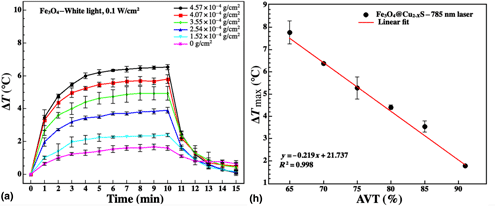Crossref Citations
This article has been cited by the following publications. This list is generated based on data provided by
Crossref.
Lyu, Mengyao
Lin, Jou
Krupczak, John
and
Shi, Donglu
2020.
Light angle dependence of photothermal properties in oxide and porphyrin thin films for energy-efficient window applications.
MRS Communications,
Vol. 10,
Issue. 3,
p.
439.
Yang, Daozheng
Zhou, Bing
Han, Gaojie
Feng, Yuezhan
Ma, Jianmin
Han, Jian
Liu, Chuntai
and
Shen, Changyu
2021.
Flexible Transparent Polypyrrole-Decorated MXene-Based Film with Excellent Photothermal Energy Conversion Performance.
ACS Applied Materials & Interfaces,
Vol. 13,
Issue. 7,
p.
8909.
Khaled, Khaled
and
Berardi, Umberto
2021.
Current and future coating technologies for architectural glazing applications.
Energy and Buildings,
Vol. 244,
Issue. ,
p.
111022.
Lyu, Mengyao
Lin, Jou
and
Shi, Donglu
2021.
Solar Desalination via Multilayers of Transparent Photothermal Fe3O4@Cu2–xS Thin Films.
Energy Technology,
Vol. 9,
Issue. 11,
Lyu, Mengyao
Lin, Jou
Krupczak, John
and
Shi, Donglu
2021.
Solar Harvesting through Multilayer Spectral Selective Iron Oxide and Porphyrin Transparent Thin Films for Photothermal Energy Generation.
Advanced Sustainable Systems,
Vol. 5,
Issue. 6,
Deng, Zicheng
Lin, Jou
Bud’ko, Sergey L.
Webster, Brent
Kalin, Tanya V.
Kalinichenko, Vladimir V.
and
Shi, Donglu
2021.
Dual Targeting with Cell Surface Electrical Charge and Folic Acid via Superparamagnetic Fe3O4@Cu2–xS for Photothermal Cancer Cell Killing.
Cancers,
Vol. 13,
Issue. 21,
p.
5275.
Zhang, Enhe
Duan, Qiuhua
Wang, Julian
Zhao, Yuan
and
Feng, Yanxiao
2021.
Experimental and numerical analysis of the energy performance of building windows with solar NIR-driven plasmonic photothermal effects.
Energy Conversion and Management,
Vol. 245,
Issue. ,
p.
114594.
Lin, Jou
and
Shi, Donglu
2021.
Photothermal and photovoltaic properties of transparent thin films of porphyrin compounds for energy applications.
Applied Physics Reviews,
Vol. 8,
Issue. 1,
Lin, Jou
Krupczak, John
and
Shi, Donglu
2022.
Solar harvesting and energy generating building skins with photothermal–photovoltaic dual-modality based on porphyrin thin films.
MRS Communications,
Vol. 12,
Issue. 6,
p.
1225.
Anwar Jahid, Md
Wang, Julian
Zhang, Enhe
Duan, Qiuhua
and
Feng, Yanxiao
2022.
Energy savings potential of reversible photothermal windows with near infrared-selective plasmonic nanofilms.
Energy Conversion and Management,
Vol. 263,
Issue. ,
p.
115705.
Lin, Jou
Wang, Yuxin
Lyu, Mengyao
Deng, Zicheng
and
Shi, Donglu
2022.
Transparent porphyrin-based hybrid films for spectral selective solar harvesting and energy generation.
Solar Energy Materials and Solar Cells,
Vol. 243,
Issue. ,
p.
111788.
Roca, A.G.
Lopez-Barbera, J.F.
Lafuente, A.
Özel, F.
Fantechi, E.
Muro-Cruces, J.
Hémadi, M.
Sepulveda, B.
and
Nogues, J.
2023.
Iron oxide nanoparticles (Fe3O4, γ-Fe2O3 and FeO) as photothermal heat mediators in the first, second and third biological windows.
Physics Reports,
Vol. 1043,
Issue. ,
p.
1.
Shum, Caitlyn
and
Zhong, Lexuan
2023.
A review of smart solar shading systems and their applications: Opportunities in cold climate zones.
Journal of Building Engineering,
Vol. 64,
Issue. ,
p.
105583.
Lin, Jou
Lyu, Mengyao
and
Shi, Donglu
2023.
3D Solar Harvesting and Energy Generation via Multilayers of Transparent Porphyrin and Iron Oxide Thin Films.
Energies,
Vol. 16,
Issue. 7,
p.
3173.
Pu, Jihong
Shen, Chao
and
Lu, Lin
2023.
Investigating the annual energy-saving and energy-output behaviors of a novel liquid-flow window with spectral regulation of ATO nanofluids.
Energy,
Vol. 283,
Issue. ,
p.
129111.
Sadat, Md Ehsan
Bud’ko, Sergey L.
Ewing, Rodney C.
Xu, Hong
Pauletti, Giovanni M.
Mast, David B.
and
Shi, Donglu
2023.
Effect of Dipole Interactions on Blocking Temperature and Relaxation Dynamics of Superparamagnetic Iron-Oxide (Fe3O4) Nanoparticle Systems.
Materials,
Vol. 16,
Issue. 2,
p.
496.
Lyu, Mengyao
Lin, Jou
Wang, Yuxin
Krupczak, John
and
Shi, Donglu
2023.
Synergistic photothermal-thermoelectric-photovoltaic energy generation via a transparent spectral modulating solar module.
Solar Energy,
Vol. 258,
Issue. ,
p.
220.
Lin, Jou
Lyu, Mengyao
Wang, Yuxin
Webster, Brent
and
Shi, Donglu
2023.
Advanced Materials in Smart Building Skins for Sustainability.
p.
1.
Zaccagnini, Federica
Radomski, Piotr
Sforza, Maria Laura
Ziółkowski, Pawel
Lim, Seok-In
Jeong, Kwang-Un
Mikielewicz, Dariusz
Godman, Nicholas P.
Evans, Dean R.
Slagle, Jonathan E.
McConney, Michael E.
De Biase, Daniela
Petronella, Francesca
and
De Sio, Luciano
2023.
White light thermoplasmonic activated gold nanorod arrays enable the photo-thermal disinfection of medical tools from bacterial contamination.
Journal of Materials Chemistry B,
Vol. 11,
Issue. 29,
p.
6823.
Lyu, Mengyao
Lin, Jou
Wang, Yuxin
Aulakh, Ovais
Ceja, Nathan
Ramesh, Mary Sheryl
Salazar, Elisabeth
Krupczak, John
and
Shi, Donglu
2023.
Enhanced Silicon Photovoltaic Efficiency by Solar Light Spectral Modulation via Photonically Tuned Porphyrin–Iron Oxide Hybrid Thin Films.
Energy Technology,
Vol. 11,
Issue. 7,






